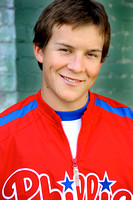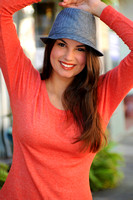Professional Headshots
Many casting directors and scouts are seeking a particular look or need only an identifying headshot. They most often are interested in a face, not a fashion identity. Besides primary roles, they also need people for fill-in, background, featured extras, or people with certain characteristics or who look like a particular character in their “story”.
A professional headshot is often the ONLY thing they will accept, so it is smart to have a headshot as well as a comp card in addition to your portfolio book.


Headshots are usually 8”x10”. The back is left blank and that is a good place to attach your resume page. The resume can be stapled to the back of the headshot, and I have even seen people run off their resume on the back of the headshot card. Hey, the casting director can’t loose it that way!
As for whether to have a color or black and white headshot, it depends on the individual’s desires.



 One casting director I know wants only black and white headshots. He puts them all up on the wall and when he needs a certain “look”, he can scan the wall for a match and is not distracted by colors.
One casting director I know wants only black and white headshots. He puts them all up on the wall and when he needs a certain “look”, he can scan the wall for a match and is not distracted by colors.
Yet, color headshots are almost universally accepted by casting people, and when they present the headshots to the client or producer, those folks seem to like color. So, it can be an either/or/ . . or both choice.
Some very successful models and actors have a variety of headshot “looks”. Most of the time, when going on an audition, the role you are auditioning for is known. If they are looking for an on-the-job mechanic, a rather casual, maybe scruffy look fills the bill. But if they are looking for a pharmaceutical salesman, a more upscale or corporate look is the headshot card you want to take to leave with them.
In todays’ competitive market, cover your bases well.
Portfolio Photos
In your professional portfolio book, you want pictures that show your various looks from casual to corporate and other directions in between. Your portfolio book should contain professional pictures only—no homemade snapshots, prom pictures, the school play, etc.—save those for your scrapbook at home.

 Your portfolio should contain a variety of outfits, attitudes and may be a mix of color and black and white images. Your book may contain 20 or more shots, but avoid duplicating certain outfits and looks just to fill the book. A well thought-out book will contain the best pictures and variety and 10 knockout pictures is far more effective than an additional dozen repeats or “so-so” photos.
Your portfolio should contain a variety of outfits, attitudes and may be a mix of color and black and white images. Your book may contain 20 or more shots, but avoid duplicating certain outfits and looks just to fill the book. A well thought-out book will contain the best pictures and variety and 10 knockout pictures is far more effective than an additional dozen repeats or “so-so” photos.
if your interest includes Modeling, Acting, Entertainment, Television or Film, we highly recommend Z-1 Models & Talent and their associated American Talent Showcase.